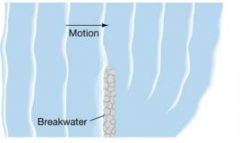![]()
![]()
![]()
Use LEFT and RIGHT arrow keys to navigate between flashcards;
Use UP and DOWN arrow keys to flip the card;
H to show hint;
A reads text to speech;
20 Cards in this Set
- Front
- Back
|
1. What is the name of the temperature scale thatplaces zero at the point where all atomic and molecular motion ceases? |
a. Kelvin |
|
|
1. The frequency of a water wave gives us itsheight? |
a. False |
|
|
1. Which of these is not a form of electromagneticradiation? |
a. DC current from your car battery |
|
|
1. If a new wave arrives on shore every 2 seconds,then its frequency is 2 Hz |
a. False, it is 0.5 Hz |
|
|
1. Which of these is the same for all forms of EMRin a vacuum?_ |
a. Speed] |
|
|
7. In electromagnetic waves, the electric andmagnetic waves vibrate ______ to each other. |
a. Perpendicular |
|
|
Changing the electric field will hav eno effect on the magnetic fields of a body: |
False |
|
|
A wave's velocity is the product of the: |
Frequency times the wavelength of the wave
|
|
|
If a wave's frequency doubles and its speed stays the same, it's wavelength will: |
be halved
|
|
|
The distance from a wave's crest to its undisturbed position is the: |
amplitude
|
|

Is demonstrating |
Diffraction
|
|
|
Medium A blocks more of a certain wavelength of radiation than medium B. Medium A has a higher |
Opacity |
|
|
Visible light has a wider frequency range than any of the other types of electromagnetic radiation |
False |
|
|
In the Kelvin scale, absolute zero lies at
|
Zero K
|
|
|
How much stronger is the gravitational pull of the sun on earth, at 1 AU, than it is on saturn at 10 AU?
|
100
|
|
|
If the distance between two asteroids is doubled, the gravitational force they exert on each other will be |
1/4 as great
|
|
|
The two forms of electromagnetic (E-M) radiation that experience the least atmospheric opacity are:
|
visible light and radio waves |
|
|
The force of gravity varies with the |
Product of the two masses AND the inverse square of the distance separating the two bodies |
|
|
The speed of light in vacuum is: |
300,000 km/second |
|
|
A wave with a period of 0.01 seconds has a frequency of: |
100 Hz |

